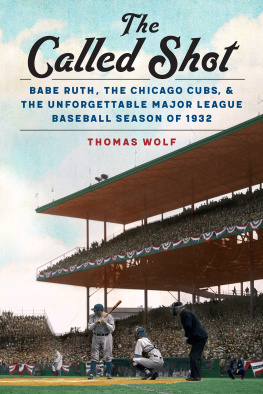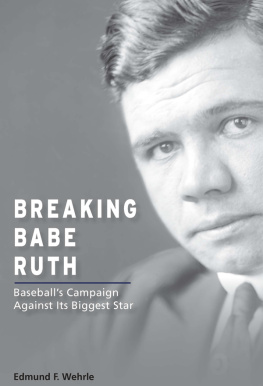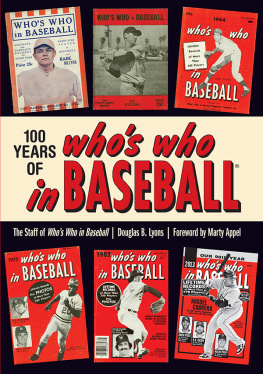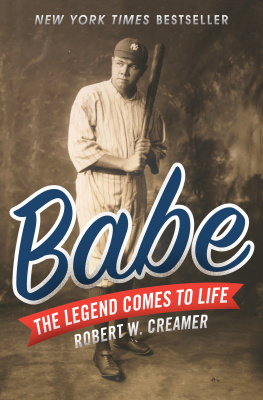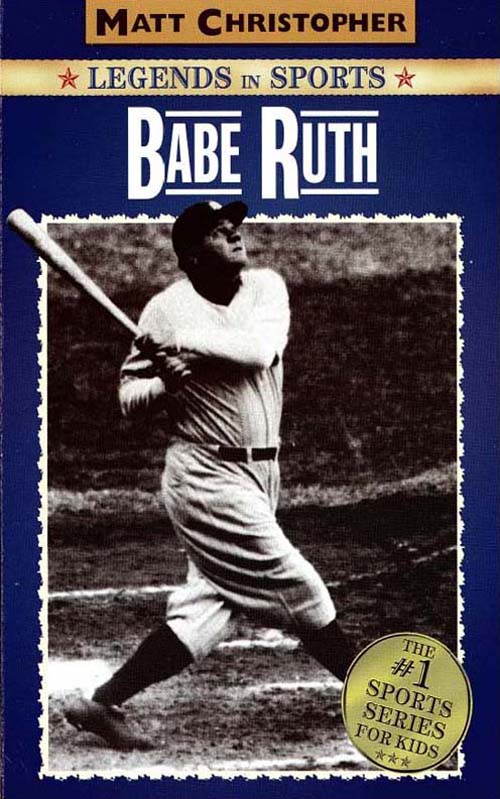Copyright 2005 by Matt Christopher Royalties, Inc.
All rights reserved. Except as permitted under the U.S. Copyright Act of 1976, no part of this publication may be reproduced, distributed, or transmitted in any form or by any means, or stored in a database or retrieval system, without the prior written permission of the publisher.
Little, Brown Books for Young Readers
Hachette Book Group
237 Park Avenue
New York, NY 10017
Visit our website at www.HachetteBookGroup.com
www.twitter.com/littlebrown
Little, Brown Books for Young Readers is a division of Hachette Book Group, Inc.
The Little, Brown name and logo are trademarks of Hachette Book Group, Inc.
First eBook Edition: December 2009
Matt Christopher is a registered trademark of Matt Christopher Royalties, Inc.
ISBN: 978-0-316-09373-6
A teammate of Babe Ruth once said, I saw a man transformed from a human being into something pretty close to a god. Indeed, Babe Ruth is one of baseballs legendary figures, a player unlike anyone before or since. His booming home runs changed the game forever. There will never, ever be another ballplayer like the Babe.
Baseball historians consider George Herman Babe Ruth one of the greatest players in the history of baseball, a star both on the mound and at the plate. During his first six seasons in the major leagues, Babe Ruth was one of the most successful pitchers in baseball, winning eighty-nine regular season games and three more for the Boston Red Sox in the World Series. Then he became the greatest slugger of his time, hitting home runs faster and farther than anyone who had ever played the game. He played the bulk of his career with the New York Yankees and ended with 714 home runs, a record that held until Hank Aaron broke it in 1974.
Yet for all his individual accomplishments, Babe Ruth was also a team player. He helped the Red Sox to three pennants and world championships. Then, after he was purchased by the Yankees after the 1919 season, Ruth led New York to seven pennants and four world championships, creating the Yankee dynasty that continues to this day.
But statistics and championships dont even begin to tell his story, for in addition to his accomplishments on the field, Ruth is unquestionably the most beloved baseball player in history. Baseball fans loved him for his talent, his generous personality, his ready smile, and his enormous heart. Ruth never lost sight of the fact that baseball was a game meant to be played. He was like an oversized kid, and he played baseball with simple joy.
Even today, nearly sixty years after his death in 1948, he remains the most popular baseball player of all time. Wherever kids gather to play baseball, young boys and girls still step up to the plate and dream of being Babe Ruth.
Yet few people realize what a difficult life Babe Ruth had, particularly when he was young. Due to his harsh upbringing, Ruth entered adulthood still thinking and acting like a child. He struggled most of his adult life to behave responsibly. For all his accomplishments on the field, Ruths greatest victories were with himself.
Babe Ruth began life in Baltimore, Maryland, on February 6, 1895, as George Herman Ruth Jr., the firstborn child of two German Americans, George and Kate Ruth. From the start, the young family had a tough time. George Ruth Sr. had trouble finding work and had to leave Kate home alone with their son. But Kate was not a strong woman. Her illnesses prevented her from giving George Ruth Jr. as much attention as he needed. And when his sister, Mary Margaret, was born, five-year-old George was left to take care of himself as best he could.
Babe Ruth later admitted that he was a bad kid, who had no sense of right or wrong. Every morning he took to the streets with other unfortunate boys. Although they often played childrens games, including baseball, without adult supervision, they frequently caused trouble. They stole food and money, committed vandalism, chewed tobacco, and fought among themselves and against children from other neighborhoods.
Young George rarely went to school. His parents tried to force him to go, but even beatings with a leather strap couldnt make him obey. Every day he became more uncontrollable. When he wasnt on the streets, he hung around the saloon his father owned hardly a good place for a young boy to grow up. At an age when he should have been learning to read and write, he was drinking alcohol and stealing whiskey from customers.
One night, when George was seven years old, police were called to break up a brawl in the saloon. Afterward, a neighbor told the authorities that she had noticed George was in the saloon when he should have been attending school. The Ruths were ordered to send George to Saint Marys Industrial School for Boys in the city of Baltimore.
Operated by the Xaverian Brothers of the Catholic Church, St. Marys was a training school for orphans, delinquents, and other poor young boys in need of help. More than eight hundred boys, ranging from the age of seven to eighteen, lived and studied at St. Marys. Discipline under the brothers was strict. The boys were told what to do and when to do it. The students, who referred to themselves as inmates, all slept in dormitories and were not allowed to leave St. Marys without supervision.
Young George arrived at St. Marys on June 13, 1902. Its imposing gray stone buildings and high wooden fence made it look like a prison. George didnt understand what St. Marys was or why he was there. When his father escorted him to the school office, said good-bye, and left, George (the foul-mouthed, tobacco-chewing street urchin) suddenly discovered he wasnt so tough. Alone and afraid, he began to cry.
Fortunately, the Xaverians understood young boys like George. They knew such boys werent bad they just needed someone to pay attention to them and provide them with some direction, discipline, and love. They tried to provide each boy with an education and a skill that would eventually allow each of them to earn a living and become a good, responsible citizen.
George was kept so busy at St. Marys that he didnt have time to get into trouble. All the boys awoke each morning at six, attended church, ate breakfast, and then spent five hours in school either learning academic subjects or studying for a trade. After a two-hour break for lunch and recess, they spent another two hours either in class or, if they were over twelve years old, working. Before dinner the boys were encouraged to play sports. They were then allowed to read for forty-five minutes before going to bed at 8:15. They attended school five days a week plus a half day on Saturday. After church services on Sundays they were free to participate in school sports, play in the band, and take part in other similar activities.
At first, George hated St. Marys. No one had ever told him when to get up in the morning, when to eat, what to wear or do, or when to go to bed. After all, he had always done as he pleased before, and now suddenly the brothers were telling him what to do every minute of the day.
Each brother was assigned eight or ten boys to watch over. Brother Matthias, the head of discipline at St. Marys, was assigned to look after young George Ruth. An enormous man who stood nearly six and a half feet tall and weighed nearly three hundred pounds, Matthias looked as if he could break a person in half with his bare hands.








